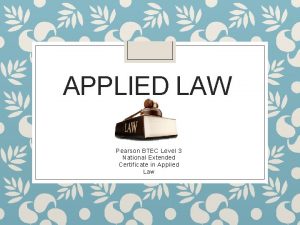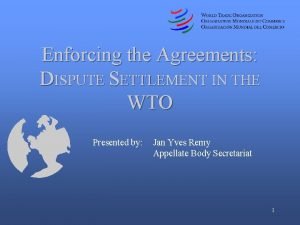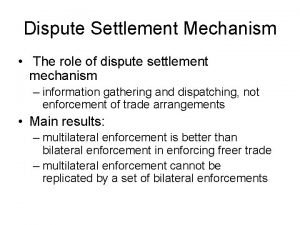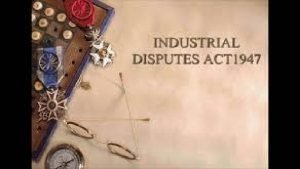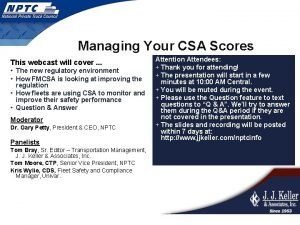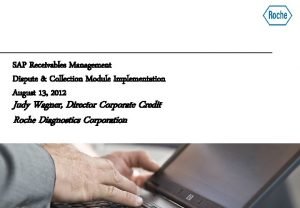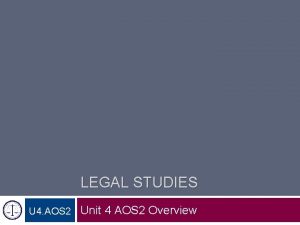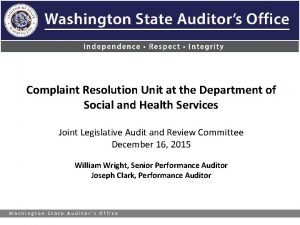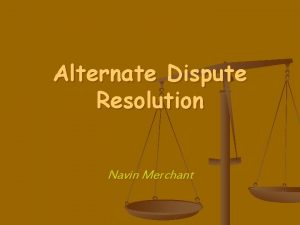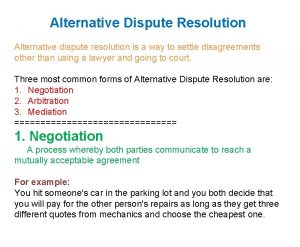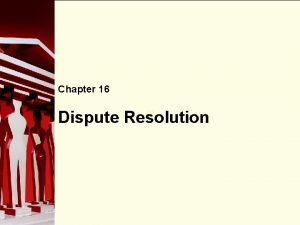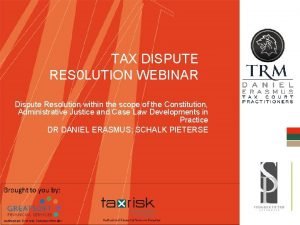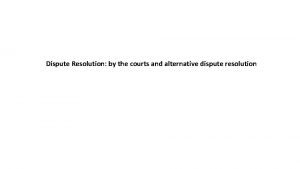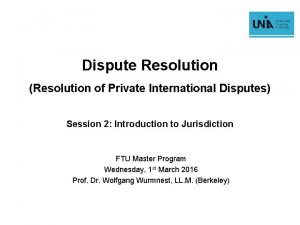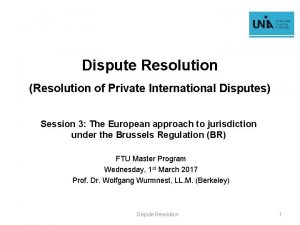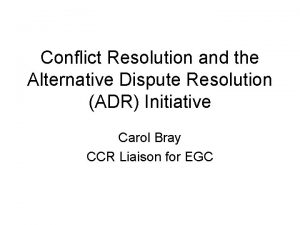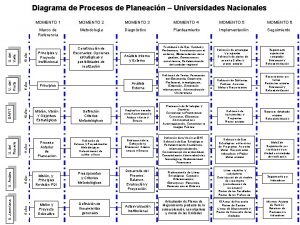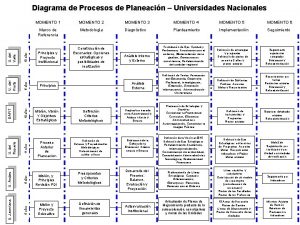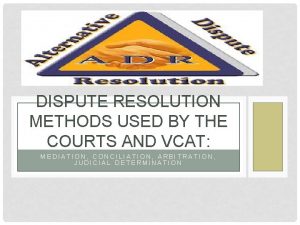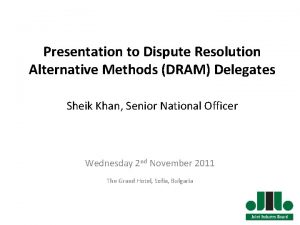UNIT 4 AOS 1 DISPUTE RESOLUTION METHODS UNIT























- Slides: 23

UNIT 4 AOS 1 “DISPUTE RESOLUTION METHODS

UNIT 4 • The focus of Unit 4 Legal Studies is on the way in which criminal cases and civil disputes are resolved through the Victorian Legal System • Consideration is given to the dispute resolution bodies and the processes and procedures that operate within them • You are expected to evaluate the effectiveness of these processes and procedures

IS IT CRIMINAL OR CIVIL? • Mr Pie was commissioned by Mr Tiggie to make a new tuxedo for him. Mr Tiggie took Mr Pie’s measurements and Mr Pie described what he wanted and chose a fabric. • When Mr Pie went to pick up his new suit, the fabric was wrong and the suit was not the correct measurements and didn’t fit poor Mr Pie’s furry little body. • Because of this, Mr Pie couldn’t attend the most soiree of the season and became a social outcast. Mr Tiggie is now refusing to return Mr Pie’s money.

SWIMMER IN HOT WATER • In March 2008, 20 -year-old Nick D'Arcy, a member of the Australian Olympic Swimming squad, assaulted fellow swimmer Simon Cowley, aged 27 years, at a hotel in Sydney. Mr D'Arcy admitted striking Mr Cowley once in the face with his elbow, fracturing his nose, jaw and eye socket in several places, although claimed he was acting in self-defence after being slapped by Mr Cowley. The incident resulted in both criminal and civil actions and therefore different methods of dispute resolution. • After the incident, criminal proceedings were commenced against Mr D'Arcy and, in 2009, he pleaded guilty to the charge of ‘recklessly causing grievous bodily harm’. He was sentenced to 14 months imprisonment, wholly suspended, meaning he was not required to attend prison providing he adhered to certain conditions imposed by the court. • Mr Cowley also sued Mr D'Arcy in a separate civil action. In July 2011, Judge Puckeridge found that Mr D'Arcy had assaulted Mr Cowley and breached his individual rights. Mr D'Arcy was ordered to pay Mr Cowley $180 000, plus interest (referred to as damages) to compensate Mr Cowley for the losses he had incurred as a result of the assault.

CIVIL OR CRIMINAL?

• Every day in the media we read or hear about people being involving in a range of legal disputes. • For example, we hear about individuals who have been charged with, or are being sentenced for, committing criminal offences. • We hear stories from victims of crime. We also hear about legal disputes involving an alleged breach of an individual's rights; for example, disputes where individuals claim they have been discriminated against or have suffered due to someone else's carelessness. • In Victoria the legal system provides courts as well as less formal tribunals to help resolve the wide range of legal disputes that arise within our community. • We also have a range of methods that can be used to resolve legal disputes, including having a judge determine the outcome, or having parties discuss and negotiate their own settlement.

KEY KNOWLEDGE FOR UNIT 4 SAC 1

• The Victorian legal system provides a range of courts and less formal tribunals with the power or jurisdiction to hear and determine both criminal cases and civil disputes that arise within our community. • It is important to distinguish between criminal and civil matters because different legal processes and procedures are applied to each.

CRIMINAL LAW • Definition: Criminal law hears crimes, which are acts or omissions that are against the law, harmful to society or an individual and punishable by law. They are offences against the state, eg murder. • Aim: to protect society and uphold the rules of society, and punish offenders • Parties to a case: Director of Public Prosecutions and the Accused

SUMMARY OFFENCES • If an alleged offender is charged with committing a less serious offence, referred to as a summary offence, such as a traffic infringement or minor theft, the matter will be heard in the Magistrates' Court — the lowest court in the Victorian court hierarchy. • In these cases the police are responsible for prosecuting the case against the alleged offender, called the defendant, and a magistrate determines the outcome of the case. • If the defendant pleads guilty to the charges laid against them the magistrate will determine their sanction or punishment. • If the defendant pleads not guilty the magistrate will determine the verdict (whether the defendant is guilty or not guilty) and the sanction.

INDICTABLE OFFENCE • If an alleged offender is charged with committing a serious offence, referred to as an indictable offence, such as drug trafficking, serious sexual assault and homicide, the Office of Public Prosecutions (OPP) is responsible for prosecuting the case against them. • While some indictable offences may be heard by a magistrate, if the OPP can establish they have sufficient evidence against a defendant, generally a trial will be held in a higher court — either the Victorian county or supreme courts.

DEFINITIONS • Summary offence: A summary offence is a less serious offence, such as minor traffic offences and shop stealing, heard in the Magistrates' Court and found in the Summary Offences Act. • Indictable offence: An indictable offence is a serious offence, such as drug trafficking and dangerous driving causing death, and is usually heard before a judge and jury.

BURDEN OF PROOF • The burden of proof is the obligation on a party to prove matters that it alleges during a court trial. The general burden of proof rests on the party that began the proceedings • This is the prosecution/DPP in a criminal case, or the plaintiff (or applicant) in a civil dispute.

STANDARD OF PROOF • The standard of proof is the extent to which a party must prove a case or an assertion during a trial. • The criminal standard (beyond reasonable doubt) is a much higher standard than the civil standard (balance of probabilities). • Criminal: beyond reasonable doubt

JURY? • No jury in the Magistrates’ Court but compulsary jury of 12 (up to 15 in lengthy trial) for Indictable offences in County and Supreme Courts.

VERDICT • Guilty or not guilty.

CIVIL DISPUTES • Definition: Civil law is concerned with the infringement of an individual or group’s rights with the aim of seeking a remedy • Aim: to regulate conduct between parties and provide a remedy to an injured party, restoring them to their original position or compensating them. • Parties to a case: Plaintiff (who is “complaining” and defendant.

CIVIL LAW CONTINUED… • Burden of proof: on the plaintiff • Standard of proof: On the balance of probabilities (who was most probably wrong) • Jury: no jury in the Magistrates’ Court, optional jury of six (up to 8 in lengthy trial) in County and Supreme Courts

DARCEY'S DEATH CAUSES CRIMINAL AND CIVIL ACTIONS • In March 2011, a Supreme Court jury found Mr Arthur Freeman guilty of murder after he threw his 4 -year-old daughter, Darcey, from the West Gate Bridge in January 2009. • Mr Freeman pleaded not guilty and his lawyers argued the defence of mental impairment, claiming Mr Freeman was suffering a significant depressive disorder at the time of the incident. • Mr Freeman was sentenced to life imprisonment and, after losing an appeal against the severity of his sentence in 2012, will spend 32 years in prison before being eligible for parole. • In January 2012, Ms Peta Barnes, Darcey's mother, commenced a civil action against Vic. Roads, claiming the Victorian Roads Authority was negligent by ignoring recommendations to install anti-jump fencing along the West Gate Bridge and therefore contributed to Darcey's death. • Ms Barnes sued Vic. Roads for losses she suffered as a result of the nervous shock caused by the death of her daughter.

REASONS FOR A COURT HIERARCHY


IF THERE WERE NO COURT HIERARCHY: • The doctrine of precedent could not operate as there would be no lower courts to follow the ratio decidendi of higher courts in like cases. • Appeals: this provides fairness and the opportunity for unjust decisions to be rectified. Without a court hierarchy, this avenue for appeal to a superior court would not exist, as there would be no superior courts. • Specialisation: without a court hierarchy, every court would hear all types of cases and no expertise could be established

ADMINISTRATIVE CONVENIENCE: • A court hierarchy allows for the superior courts to hear the more serious, complex and lengthy cases while lower courts hear minor, shorter cases. This helps reduce delays in lower courts by allowing minor cases to be dealt with quickly. Without a court hierarchy, delays and confusion may exist.
 Msc construction law and dispute resolution
Msc construction law and dispute resolution Applied law unit 3 past papers
Applied law unit 3 past papers High resolution low resolution
High resolution low resolution Esi act applicability
Esi act applicability Krishna godavari dispute
Krishna godavari dispute Objectives of industrial dispute act 1947
Objectives of industrial dispute act 1947 Wto dispute settlement mechanism
Wto dispute settlement mechanism Dispute settlement mechanism meaning
Dispute settlement mechanism meaning Rights dispute
Rights dispute Objectives of industrial dispute act 1947
Objectives of industrial dispute act 1947 Maine vs canada war
Maine vs canada war Relic boundary example
Relic boundary example Uces dispute letters
Uces dispute letters Allocational boundary dispute
Allocational boundary dispute How to dispute csa points
How to dispute csa points Dispute management ai
Dispute management ai Delay and dispute mitigation
Delay and dispute mitigation Sap receivable management
Sap receivable management Credit management in o2c
Credit management in o2c Indirect wax pattern
Indirect wax pattern Psychology unit 4 aos 2
Psychology unit 4 aos 2 Unit 4 aos 2 legal studies
Unit 4 aos 2 legal studies Hhd unit 4 aos 2
Hhd unit 4 aos 2 Complaint resolution unit
Complaint resolution unit

